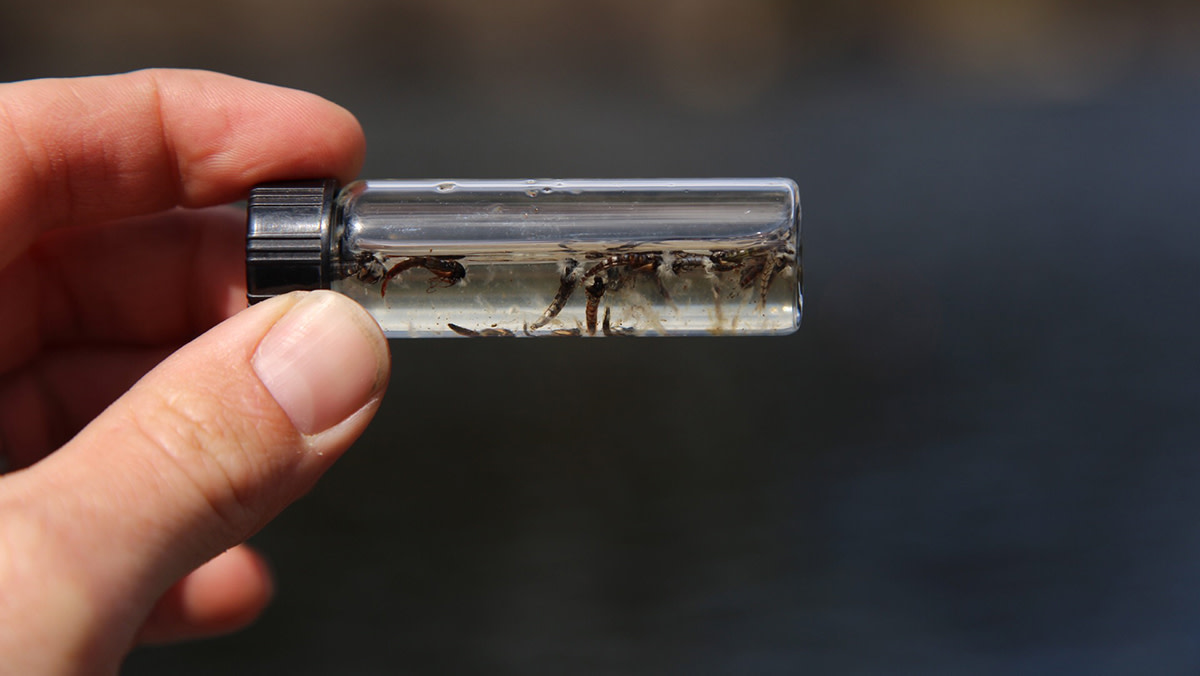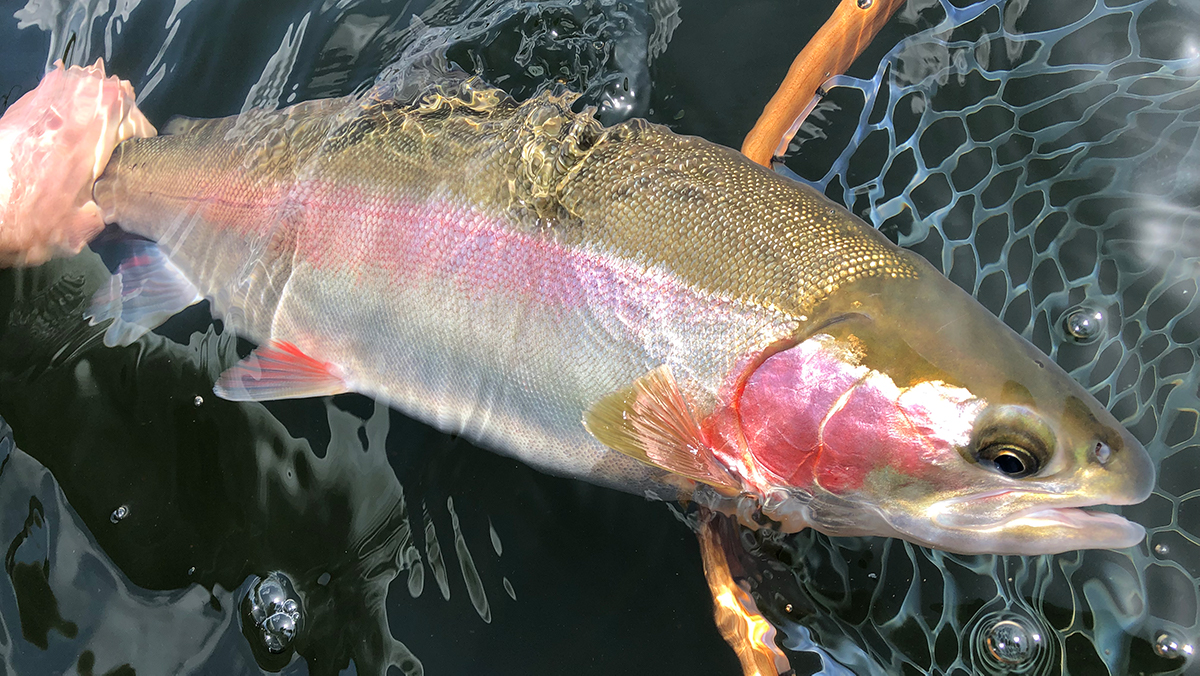
When I was little, my dad and I used to go on an annual fishing trip in British Columbia’s interior. In the excitement leading up to the trip, I polished my Wedding Ring and Willow Leaf spinners before organising them into their designated Plano compartments. As a treat, Mom let me stay up late and armed me with a flashlight to raid the backyard for nightcrawlers.
Once on the lake, Dad and I motored around in search of gullible trout and, every so often, we actually connected to one. Mostly though we just caught bad weather and two-stroke fumes. We trolled without rhyme or reason, only ever stopping to deal with engine trouble and squiggling worms. We assumed shinier lures and bigger baits meant more fish, so when I learned that we were being out-fished by fly anglers casting a tiny, nearly-bare hook called a “cromimid ,” I was shocked.
We knew fishing was tough and that we were rookies, but never in a million years did we think we were being put to shame by a little maggot look-alike in shiny clothes. If you’re like we were, trolling expensive lures and immaculate earthworm harnesses wondering why you just can’t seem to catch a damn thing, this article is for you.
It Starts In Your Mind
We may as well start out with the biggest obstacle in chironomid fishing: pronunciation. While it doesn’t really matter how you say the word, you’ll have more confidence exploring it if you feel comfortable using it in a sentence. It’s pronounced “ker-ON-oh-mid,” though “CRON-oh-mid” will get you through a conversation.
The chironomid is one of the many unfortunate casualties in the fly fishing misconception war. Anglers who avoid fly fishing because they assume it’s less effective do themselves a major disservice by assuming this is the case in lakes and ponds. Chironomids make up an enormous part of trout diets all across North America, all year long. Almost anywhere you go, chironomid imitations will often work just as well as worms and lures in slow and stillwater situations. They can be fished just as effectively on conventional tackle as well.
But What Is It?
Picture this. You’re camping, the sun is low, dinner is simmering, the lake is glassy, loons are howling and everything is perfect except for the thousands of mosquitoes hovering over the lake. A closer look, however, determines that they’re not mosquitoes at all. They’re actually midges, small black flies resembling mosquitos—only without the desire to suck blood.
I’ll spare you the entire entomology lesson, but the name “chironomid” is used to refer to thousands of members of the globally-distributed family Chironomidae, non-biting aquatic midges. You may have also heard them called lake flies, sand flies, muffleheads or chizzywinks. By any name, anglers are generally referring to large midge pupae or adults in slow or still water.
The Life Cycle
Chironomids undergo a complete metamorphosis, meaning their life cycle has four stages: egg, larva, pupa, adult. The adult female fly deposits the egg on the water surface and it sinks to the bottom, soon after to hatch into worm-like larva. Chironomid larvae come in various sizes and colours, sometimes even bright red from the hemoglobin in their thin bodies. We call these sorts of larvae “blood worms.” But it’s the next stages in the metamorphosis that interests most anglers.
The larva typically form cases in which to become pupa. Once hatched, the pupal midge’s shiny, gas-filled body spastically jolts toward the water’s surface with the intention of emerging as a winged adult. Once it makes contact with the air, it sheds its exoskeleton, dries its wings and flies away to help start the cycle again. That’s the plan anyway—many don’t survive long enough to see it past the pupal stage as trout and other fish hone in and feast as the bugs writhe and squiggle upward.
Dorky side-note: if you’ve done some fly fishing with nymphs before, you may be more familiar with pupae than you think. Insects that transition through simple metamorphosis (three life stages, such as mayflies and stoneflies) are called nymphs in their free swimming/crawling phase, whereas those that undergo a complete metamorphosis (four life stages, such as caddis and midges) are called pupae in that form.
Fishing
When a trout is dialed in on hatching insects, it can be hard to convince it to eat anything else. They eat plenty of other things, but almost anywhere trout live, their diet will include a lot of midges. Glance inside a trout’s entrails sometime. You’ll often find nothing except mounds of partially digested midge larvae and pupae.
Though midges can be fished successfully year-round, stillwater chironomids tend to be larger and involved in more prolific hatches after lake turnover in the spring, or in the fall before the first freezes, yet hatches still happen throughout the summer. Water temperature plays an important role in most insect hatches and chironomids are no exception. On many lakes, anglers spend the cooler mornings and evenings fishing leeches or tackle, focusing on midge activity once the water heats up midday.
Where To Start
Searching around a waterbody with a chironomid imitation is never a bad idea, but to really key in with this tactic you’ll want to locate hatching midges. Boats certainly help anglers to cover more water, though they don’t need to be anything fancy. Belly boats, canoes, pontoons, prams and small car-toppers all work well for lake fishing. Start by rowing around looking for signs of a chironomid hatch. An obvious hint will be the discarded shucks from hatched pupae. This will help you determine the size of the midge that’s hatching, but it won’t necessarily show you the hatch location.
The most reliable way to track down a hatch’s coordinates is to actually spot the midges flying off the water. If you can’t see any adult midge activity, it’s worth trying to factor in water current, wind direction and strength to discover where the shucks blew in from. Hatches often occur near the shore and drop offs, and the fish usually follow the action. Sometimes the fish themselves give the hatch location away. Like a serve-yourself smorgasbord, when things are hot and heavy they’ll swim in cruising lanes, coming back for seconds, thirds and fourths.
Take Your Time
Once you have a general idea where the shucks or adults are coming from, don’t drop your anchor in haste. Peer into the water and watch to see if chironomids are emerging. It helps to have a small aquarium net handy so that you can scoop them up to further examine their size and colour. I like to have a jar or water bottle with a lid to put the squirmers inside, because once they’ve been exposed to oxygen they won’t stay pupae for long.
If you’re confident that you’ve found the source, figure out the depth of the water they’re emerging from. I used to clamp my forceps to my fly and then drop them down to the bottom. I pulled in my line by the arm’s length, counting each pull as 5 feet (depends on your height). A clip-on ice fishing depth-checker is probably a better tool. From there, ensure the wind is at your back and then reposition yourself 20 to 30 feet from the hatch before dropping your anchor. Anchors help keep your presentation on top of the hatch without drifting off it. Pontoon boats can get by with a single anchor, but prams are best positioned with an anchor set out on either end.
Depth
Now that you know where the hatch is, it’s time to determine where in the water column the fish are feeding. Again, we can often thank the fish for helping solve the puzzle. As a general rule, if you see snouts breaking the water, they’re feeding on adults on top. If you only see their dorsal fins and backs, they’re feeding on emerging pupae just under the surface. If you don’t see them at all, they’re feeding somewhere in the depths. In situations like that, it’s not a bad idea to start a couple feet off the bottom (for depths up to thirty feet). When fly casting, you’ll need to be comfortable casting long leaders before fishing such depths.
Rig Up
Every angler has their own preferred chironomid setup and technique, but the two most common methods include fishing under an indicator or slowly retrieving a naked line. When fishing under an indicator, a little bit of wind chop on the water helps to give the fly some movement. When stripping or winding in, a gradual ascent looks more natural than a quick, sharp retrieve. Neither method requires a lengthy cast—fish are regularly caught within ten feet of the boat.
Set your indicator or bobber above a long, tapered leader and tie either directly to the chironomid or to a swivel that’s attached to a few feet of tippet to the fly. Some anglers skip the swivel and prefer to fish straight to the chironomid because they believe it looks more natural in the water. Extra depth can be achieved by using a chironomid tied with a tungsten bead or on fluorocarbon leader, which sinks faster than monofilament. Some people simply use split shot weights. Casting bubbles are a great way to accomplish these same presentations using conventional tackle.
If staring at an indicator isn’t your cup of tea, feel free to leave it off and fish naked. Before stripping down to your underpants, let me explain: Fishing naked simply involves only using your line, leader and fly. To do this, cast toward the hatch and allow your fly to sink to where you believe the fish are feeding. Count how long it takes for it to sink, as this will help you be consistent and strategic when you make your next cast. From there, very slowly retrieve the chironomid. A great way to do this is with the figure-eight method , slowly wrapping each strip of line between your fingers so that your pace is slow and smooth and your line is clear, untangled and ready for action.
Other important considerations for chironomid fishing are size and color. Black, red, green and purple seem to be most common, but folks will fish just about every color in the spectrum to imitate chironomids. Imitations typically follow the form of a long, thin body tapering up to a bead head that imitates a wing case. Many fly patterns even include gills or head tufts. I used to go so far as to weave intricate details into my flies so that the thorax and abdomen were identical to the naturals, though I’ll admit that even the most basic chironomid patterns work great. Most chironomids range between sizes 12-18, with some on either side of that. Be sure to have a variety of sizes in your box and have fun using different tinsels, threads and materials. If you choose to tie your own, use a thread underbody to build up the chironomid’s taper and then simply wrap an outer colour and rib over top. Chironomids are an excellent way to get into fly tying, plus they’re inexpensive and can be made out of materials around the house.
Chironomid fishing is a great way to better understand fish behaviour and the role insects play in an ecosystem. For many anglers, it’s a gateway into fly fishing but it’s also a firsthand opportunity to learn that fish don’t always prefer the most obvious presentations. While I still occasionally use baits and lures, I usually turn to chironomids when lake fishing. It’s not as much fun as hunting for earthworms, but they sure do get the job done.
Images via Jordan Oelrich.





